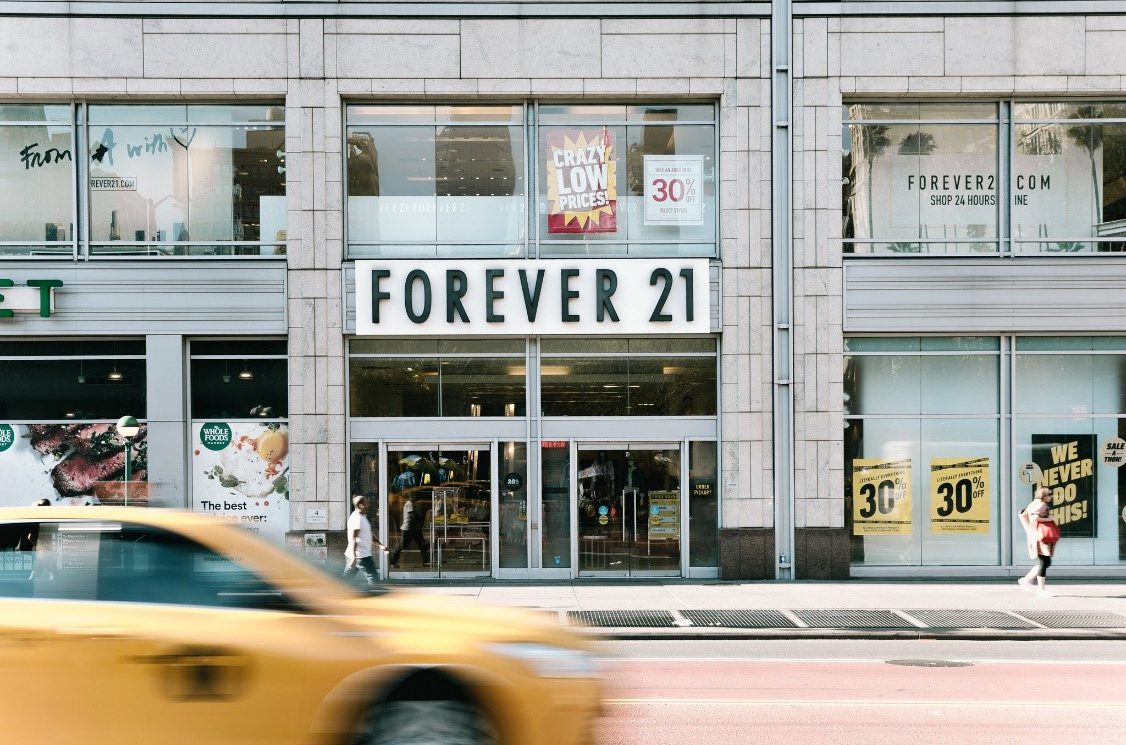From Fast-Fashion Empire to Bankruptcy: Story of Forever 21

Fast Fashion started booming in the 1960s to catch up with the trend of cheap but trendy outfits of young people. Instead of paying hundreds to thousands of dollars for items from famous catwalks, it is now easier to own similarly designed clothes at a more affordable price. However, fast fashion is entering a dark period when a series of famous brands filed for bankruptcy in the past few years.
Forever 21’s $10 club dresses, tank tops, glittery graphic tees and ripped denim shorts have been closet staples for young women across the country for years. The name is practically synonymous with fast fashion and Forever 21’s massive stores have become common fixtures in America shopping malls. But the retailer is in trouble.
At its peak, Forever 21 was a household name in fast fashion, bringing in more than $4 billion in annual sales and much of that thanks to a strong business on its home turf, which was born out of the Los Angeles fashion scene.
Forever 21 filed for bankruptcy in September 2019. When it filed for bankruptcy, Forever 21 had 785 stores, and analysts argue that was far too many. Now, Forever 21 is the story of a failed global retailer that’s still trying to bounce back. The reason given by this company is that business conditions change, the number of visitors to shopping centers decreases, the promotions are not appropriate and product errors in general. On the other hand, young customers now prefer to shop online rather than to large shopping centers. Meanwhile, the cost of renting premises at commercial centers has increased sharply. And Forever 21’s fatal mistake lies in underestimating the sophistication and intelligence of today’s young people.
The Rise of Forever 21
In 1981, 22-year-old Jin Sook and Do Won Chang touched down in L.A. from South Korea. In 1984, the couple opened a 900 square foot store called Fashion 21 in Los Angeles. It sold 700,000 dollars worth of merchandise in its first year in business. In 1987, the family renamed the business to Forever 21 and that’s also about the time the Chang started calling on their family members to help them open additional stores outside of L.A.. They started in Houston and in Northern California, and it worked. Soon they were opening a new Forever 21 store almost every six months. By 2001, Forever 21 had 122 stores and it opened its first store outside of the U.S. that year in Canada. It had 370 by 2005 and seven of those were overseas. International growth really picked up from there. It entered China in 2012, Brazil came in 2014, by 2015, Forever 21 had 251 locations outside of the U.S., spanning 40 countries across five continents.
This was also about the time that fast fashion was really heating up. Retailers were making clothes faster than ever at affordable prices, all while offering mainstream consumers budget versions of runway looks. Shoppers worldwide weren’t buying clothes like they used to, and companies weren’t making them like they used to. Clothing production globally doubled from 2000 to 2014. The number of garments produced annually topped $100 billion for the first time in 2014, and the number of garments bought by the average shopper worldwide jumped by 60 percent from 2000 to 2014. Meanwhile, across most categories of apparel, shoppers by 2014 were keeping their close about half as long as they did at the turn of the 21st century.

“The ability to now capture on the runway within seconds. Take the picture, mock stuff up, duplicate, go back to the design team, create a fabric that is reasonable that we we can afford to do price of the X. Launch it. And that’s what happened. So that the entire digital landscape has contributed because of the ease of technology, the use of technology” – said Vincent Quan, Associate Professor Fashion Institute of Technology.
As fast fashion retailers expanded their reach within the US. They took bites out of Forever 21’s business. Forever 21 lost its share of the apparel and shoe market in the US in 2016 as Zara H&M slightly gained share. “Where as Zara and H&M being able to be successful is they create a foothold here and then the scale of the market creates that chimney effect where it really allows them to take off rather quickly. And once they have established a foothold here and establish the logistics and merchandising capability of the way that they’re able to very quickly start to add to that base of business without having to recreate a lot of a lot of new infrastructure.” Greg Portell, Lead Parter A.T. Kearney said.
As of 2018, H&M and Zara are the top two apparel and footwear retailers globally, while Forever 21 ranks 17th forever ended 2018 with a 0.3% share of the clothing and footwear industry. While Japan’s Uniqlo, which entered the US in 2005, had 1.1 percent, Zara had one point two percent and H&M had 1.6 percent share. But while these rivals found fans in the US, Forever 21 wasn’t as warmly embraced outside of its home country.
Failure When Entering Overseas Market
The Chang’s probably didn’t realize back in 2015 that their business was about to go downhill fast. At the time, Forever 21 had 43,000 employees and was doing $4.1 billion in sales globally in 2014. American Eagle, which Forever 21 calls a similarly inexpensive peer, did $8 billion that year. Urban Outfitters, another so-called peer, did 3.32 billion that same year. The Chang’s were also crowned one of America’s wealthiest couples with a combined net worth reaching an estimated $5.9 billion.
The real problem is that Forever 21 just isn’t all that popular outside the U.S. It failed to localize and understand fashion taste in other countries as it built stores too big and too fast. Forever 21’s international business has been hemorrhaging cash, burning through more than $100 million annually since 2014. And it hasn’t been making enough back in America to recuperate those losses. Yet hungry for growth forever 21’s owners, the Chang family, just kept on expanding its international footprint. Between 2005 and 2015, the company opened more than 200 stores globally as part of its bankruptcy proceedings, Forever 21 says it plans to exit most of its international locations in Asia and Europe closing dozens of shops globally. The company hasn’t pegged an exact number on those plans as conversations with landlords remain ongoing and Forever 21 is still fighting for rent reductions.
The couple had said it wanted to double its company sales by 2017 and open hundreds of new stores by then. But those dreams would never be realized forever. 21’s international business was in shambles. Its styles weren’t resonating in markets where it failed to dig in and understand the kinds of clothes local consumers wanted. The sizing was off, too. The company also appeared not to do enough market research into the shopping habits of international consumers. A 2019 report from The New York Times cited employees who told the paper that Forever 21 sometimes didn’t understand local labor laws. One worker told the Times that Forever 21 moved into Germany without realizing stores in the country were typically closed on Sundays. Employees also told the paper that Forever 21 made mistakes, like not recognizing that customers in some European countries shopped for winter merchandise earlier in the year than American consumers. “Understanding the market share is probably the biggest challenge that retailers over war. The second one is just the complications of local rules and local legal contracts involving products in our countries is is different even if your insides might be free. And lastly the labor markets in these countries are also very different.” – said Greg Portell.
In 2015, the company admitted the majority of the international stores were unprofitable because of high labor costs and the fact that it’s close weren’t resonating with customers in Europe and Asia. It said sales back in the states were actually relatively strong, but its global operations were becoming a huge drag and a bigger burden than a blessing. Matters became worse when Word of Forever 21’s poor financial standing started to leak. Factory operators in China were pressuring the clothing retailer for money payments to subcontractors and stores where as much as 30 days late.
Global sales would fall from $4.1 billion in 2014 to 3.1 billion in the 12 months into July 31, 2019. The company said its stores in Canada, Europe and Asia have been losing roughly $10 million per month on average over the 12 months from September 2018 to September 2019.
Real Estate Problems of Forever 21

Big stores, both overseas and in the U.S. have become a burden for Forever 21. It used to be the bigger the store, the more and all customers would be when they walked in. Without the Internet, retailers needed aisles of shelves, thousands of square feet to be able to showcase all their merchandise. After the Great Recession rocked some American retailers in 2008 and 2009, Forever 21 said it jumped at the chance to scoop up vacant stores at cheaper prices. It bought locations from some of America’s largest retailers Forever 21 ahead by 2015, opened in 90,000 square foot store in Times Square, New York, a 94,000 square foot store in San Bernardino, California, and a 127,000 square foot store in Las Vegas to name a few examples. The average H&M. store is closer to just 20,000 square feet,. Forever 21 setup shops overseas in prime retail destinations like on London’s Oxford Street. That store was closer to 30,000 square feet in China along Shanghai’s east Nanjing Road. The city’s bustling commercial district, Forever 21, had a roughly 75,000 square foot flagship shop.
Now e-commerce has changed the need for such great size and scale. Clothing is moving online, but Forever 21 admits compared to its peers, Forever 21’s online sales as a proportion of its overall sales are low. Forever 21 launched its Website in 2005 and has said only about 16 percent of its total sales come from the Web today. Analysts would argue the same. They’ve been focused on their stores and late to the online game. In 2017, only adding to its glut of real estate, Forever 21 launched a standalone beauty concept store called Riley Rose to rival Ulta and Sephora. But that could be written off as just another distraction in bankruptcy proceedings all stand alone, Riley Rose stores are set to close.
The End of an Era
Another issue has been the overall strain that such rabid real estate expansion put on Forever 21’s supply chain. Bankruptcy documents say the large format stores forced Forever 21 to create complicated assortment strategies and triggered inventory management challenges. It became more difficult for the company to get close quickly to stores, something known as “speed to market”. The company said its European and Asian stores undermined Forever 21’s ability to nimbly bring inventory to market and by extension hurt its worldwide profitability while distracting the management team.
Forever 21 admitted, it ended up not buying enough inventory in 2017 and then bought too much in 2018. It would end up with duplicates of the same styles when it didn’t need them. That led to another big problem, Forever 21 stores across the world felt too cluttered. “With the physical presence, when you got to a Forever 21, whether it’s in Jakarta, whether it’s in Shanghai or whether it’s New York, the stores look to disheveled. Shoppers also increasingly started calling out Frevert 21’s clothing as cheap, and Zara’s was seen as a higher end, but still affordable option. The Chang’s finally fell from Forbes billionaire ranks in July of 2019, a final prelude to Forever 21 heading to bankruptcy court.
The bankruptcy shows just how difficult it can be to go global. The failures often come when companies aren’t prepared to invest in the local markets, to build out a local supply chain and to understand what shoppers there are looking for.
One bright spot has been Latin America, which Forever 21 says is its strongest outside of North America, with roughly 96 percent of its stores there generating positive cash contribution from September 2018 to September 2019. Analysts say for average 21’s clothing has resonated more in that market from a style and price perspective. The Latin American market also has seen less of an influx of competitive fashion players compared with parts of Europe and Asia.
“ You know, the question is not so much going watch what you saw, but what you get along with customers. Certainly we already knows that they really care. They care when you go into your store and it’s not merchandise. I do think that just going back to a rational watch because the customer can be very unforgiving.” – told Bill Read – Executive Vice President Retail Specialists.
Forever 21 has said in bankruptcy documents about its future: “In an ever shifting retail landscape that has seen dozens of casualties over the last several years. The traits that initially led to the success of Forever 21 collaboration, grit and creativity are the same traits that will propel Forever 21 through these Chapter 11 cases successfully…”
The Failure to Win Over Gen Z
It is not the rise of online shopping, it is the failure to care about the tastes, interests and living concepts of Generation Z that caused Forever 21 to go bankrupt.

Teenage clothing store brand Forever 21 filed for bankruptcy on Sunday, saying it will close 178 stores in the U.S. in an attempt to overhaul its strategy. Worldwide, the brand will close 300 to 350 locations and said it wants to pull out of Asian and European markets entirely.
Forever 21 sales peaked in 2015, at $4.4 billion – the brand’s peak in popularity with teen consumers likely came earlier than that. While around 9 to 10 percent of U.S. teens listed the company as their favorite clothing brand during 2009, 2010 and 2011, that number was only 8 percent in early 2014 and has been as low as 5 percent since the fall of 2016.
The same survey which rendered these results has been showing for years that young consumers have been moving their business online and have been spending on athletic wear and sportswear more heavily.

Forever 21 Turn to E-Commerce After Its Retail Failure
Fast fashion brand Forever 21 has announced its e-commerce strategy targeting consumers in Canada, Asia Pacific and Latin America. It has now tapped e-commerce specialist Global-e to work on an improved and localized e-commerce experience for international shoppers.
According to Forever 21, implementing Global-e’s cross-border e-commerce solution will allow it to provide its customers in Canada, APAC and LATAM with an enhanced online shopping experience based on local market’s characteristics and shoppers’ preferences. With Global-e, Forever 21 can now tailor its offering per market according to its marketing strategy and business goals, including running market-specific promotions.
“E-commerce forms a large chunk of the profitable core of our operations and as part of our new global strategy, Forever 21 will leverage Global-e’s technology to offer international customers an outstanding online experience. To engage digitally-savvy consumers today, retailers need to invest in creating a unique online experience that speaks directly to the shopper,” said Alex Ok, president of Forever 21.
“With the continued increase in demand from international shoppers for our brand, we recognized that an advanced global online shopping experience is a fundamental part of our future growth. The seamless localized shopping experience our consumers around the world can now enjoy is a vital milestone in our mission to use the latest retail technology to bridge the online gap between the convenience of ecommerce and the local experience of in-store.”
If you’re unable to shift along with your consumers, use data to augment profits & eliminate waste, and better cater to the wants of your customers, then succeeding in e-commerce is not for you. As department stores like Forever 21 globally are closing brick-and-mortar stores in the face of the huge growth of e-commerce, some department stores in China are thriving with the help of technology.
The Bottom Line
Now, as it looks to right, the ship Forever 21 says it will try to refocus its product assortment, streamline its supply chain and grow sales online. It says it will try to get better at being trend right. It learned what didn’t work in Asia and Europe, and it will try to apply those lessons as it fights to win back American shoppers.








